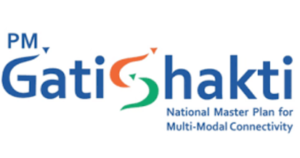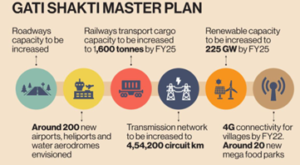PM Gatishakti Master Plan.
India showcases PM Gatishakti National Masterplan at Asian Development Bank’s 2023 Regional Cooperation and Integration Conference
Relevance
- GS Paper 2 Government policies and interventions for development in various sectors and issues arising out of their design and implementation.
- Welfare schemes, Important International institutions, agencies, and fora- their structure, and mandate.
- Tags: #pmgatishakti #ADB #india #logistic #currentaffairs #upsc.
Why in the News?
- Recently, the 2023 Regional Cooperation and Integration (RCI) Conference was organized by the Asian Development Bank (ADB) at Tbilisi, Georgia where India showcased its PM Gatishakti National Master Plan.
- During conference presentation, India introduced the audience to PM GatiShakti – National Master Plan for Multi-modal Connectivity, a groundbreaking initiative that promotes integrated infrastructure planning.
- This Made in India endeavor represents a ‘whole-of-government’ approach aimed at enhancing multimodal infrastructure connectivity to economic hubs and social facilities, thereby optimizing logistics efficiency.
Principles of PM GatiShakti
- Under PM GatiShakti, the principles emphasize area-based socio-economic development as an integral component of regional connectivity.
- The Government of India’s strategic interventions and substantial capital expenditure commitments to advance infrastructure investments.
- The adoption of geospatial and cutting-edge technologies plays a pivotal role in transforming the logistics and infrastructure ecosystem.
PM GatiShakti: A Holistic GIS-Based Approach
- PM GatiShakti has GIS data-based approach to integrated infrastructure master planning.
- Asian Development Bank (ADB) had also convened global experts to broaden the scope of its Economic Cooperation and Development (ECD) framework for regional cooperation.
- India has already operationalized and successfully implemented PM GatiShakti, which focuses on area-based infrastructure development, ultimately enhancing both Ease of Doing Business and Ease of Living.
Key Features of PM GatiShakti NMP
- PM GatiShakti National Master Plan is a GIS data-based digital platform boasting over 1400 data layers and 50+ tools.
- It provides visual representations of trunk and utility infrastructure, land use, existing structures, soil quality, habitation patterns, tourism sites, forest-sensitive areas, and more.
- The platform facilitates data-driven decision-making processes, including site suitability assessments, and operates efficiently at both the Central and State levels, promoting the adoption of PM GatiShakti principles in planning and decision-making.
Holistic Development Approach
- PM GatiShakti promotes a spatial/area-based holistic development approach. It saturates influence areas around critical project locations, industrial clusters, tourist sites, and social sector assets.
- This approach assesses connectivity infrastructure requirements, integrates manufacturing value chains, logistics facilities, social sector institutions, schools, hospitals, and skilling centers, thereby fostering comprehensive development.
Strengthening Regional Connectivity
- PM GatiShakti facilitates the expansion of the country’s multimodal corridors into hinterland areas, including industrial road corridors, dedicated rail freight corridors, and waterway networks.
- This expansion strengthens regional connectivity and trade with neighboring countries. To date, the program has evaluated 100 projects worth USD 71.26 billion, with the Network Planning Group playing a critical role in ensuring the adoption of GatiShakti principles, thus expediting infrastructure development and minimizing investment risks.
GoI’s Digital Initiatives in Logistics
- GoI’s digital initiatives in the logistics sector, including the Unified Logistics Interface Platform (ULIP) and Logistics Data Bank (LDB).
- These initiatives provide tools for trade facilitation and logistics ease, such as cargo tracking, service provider authentication, and digital document generation. They also play a significant role in attracting private sector investments.
In conclusion, PM GatiShakti approach is transforming India’s infrastructure landscape, promoting Next Generation Infrastructure, and improving both Ease of Living and Ease of Doing Business. She also offered India’s indigenously developed GIS-based technology for knowledge sharing with ADB and SASEC countries to enhance socio-economic planning and regional cooperation.
| PM Gati Shakti is based on six pillars
· Comprehensiveness: It will include all the existing and planned initiatives of various Ministries and Departments with one centralized portal. Each and every Department will now have visibility of each other’s activities providing critical data while planning & execution of projects in a comprehensive manner. · Prioritization: Through this, different Departments will be able to prioritize their projects through cross-sectoral interactions. · Optimization: The National Master Plan will assist different ministries in planning for projects after identification of critical gaps. For the transportation of the goods from one place to another, the plan will help in selecting the most optimum route in terms of time and cost. · Synchronization: Individual Ministries and Departments often work in silos. There is lack of coordination in planning and implementation of the project resulting in delays. PM Gati Shakti will help in synchronizing the activities of each department, as well as of different layers of governance, in a holistic manner by ensuring coordination of work between them. · Analytical: The plan will provide the entire data at one place with GIS based spatial planning and analytical tools having 200+ layers, enabling better visibility to the executing agency. · Dynamic: All Ministries and Departments will now be able to visualize, review and monitor the progress of cross-sectoral projects, through the GIS platform, as the satellite imagery will give on-ground progress periodically and progress of the projects will be updated on a regular basis on the portal. It will help in identifying the vital interventions for enhancing and updating the master plan. Seven Sectors to be covered under PM GatiShakti 1. Roads 2. Ports 3. Mass transport 4. Railways 5. Waterways 6. Airports 7. Logistics infrastructure |
| Asian Development Bank (ADB)
· Established: 1966 · Objective: Promoting social and economic development in Asia and the Pacific · Membership: 68 countries (49 from Asia and the Pacific, 19 from other regions) · India: Founding Member · Services: Provides loans, technical assistance, grants, and equity investments to support social and economic development Top Shareholders (as of December 31, 2022) 1. Japan and the United States: 15.6% each 2. China: 6.4% 3. India: 6.3% 4. Australia: 5.8% · Headquarters: Manila, Philippines |
Sources: PIB, Indiagov.in.
Mains Question:
Examine how the PM GatiShakti initiative contributes to India’s regional connectivity and its potential to promote seamless trade with neighboring countries. Discuss the role of geospatial and cutting-edge technologies in the implementation of PM GatiShakti 250words.





